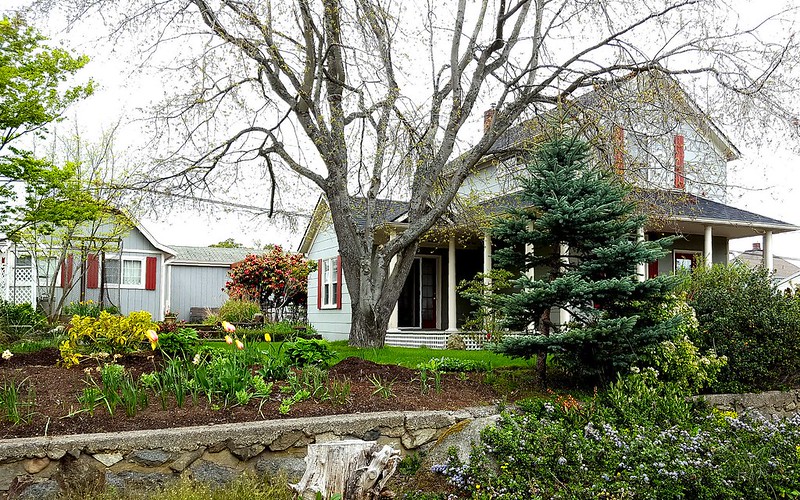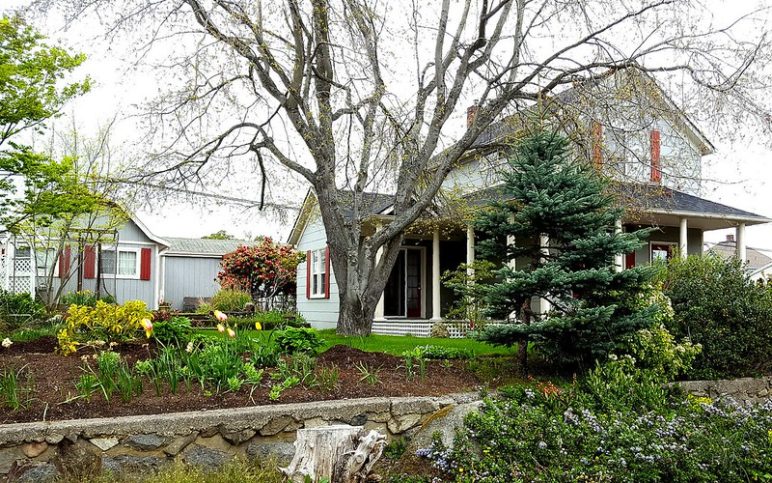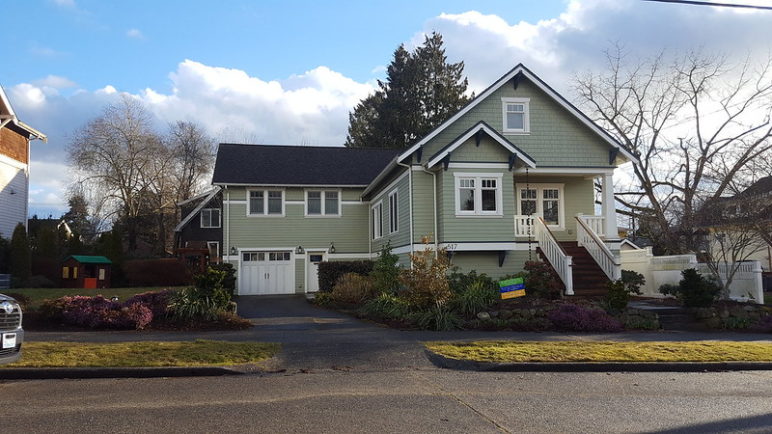Last month, California Governor Gavin Newsom signed legislation that opens up every house lot in the state to two accessory dwellings. In other words, lawmakers effectively triplexed the nation’s most populous state.
That bold move is part of a package of six new bills that establish the best statewide policy in the US for in-law suites, garage apartments, and backyard cottages—collectively termed accessory dwelling units (ADUs). And California’s new ADU rules apply not just to detached houses, but also to multi-dwelling buildings.
ADU reform in California, Oregon, Seattle, and many other Cascadian cities is part of a groundswell across North America to re-legalize homes of all shapes and sizes.

For a few months prior to the passage of California’s ADU laws, Oregon held the national crown. In 2017, Oregon legislators legalized one ADU per lot in most cities and counties, and then in the summer of 2019 they banned parking and owner occupancy requirements as part of their groundbreaking middle housing bill (HB 2001).
Earlier this year, Washington lawmakers tried to get in the game with an ADU bill that, as proposed, would have given California a run for its money. The bill failed to pass, mired in concerns over how such a law would supersede local control of land use. Legislators plan to run a similar bill again in 2020. Meanwhile, the City of Seattle updated its ADU policy this summer, enacting the most progressive set of regulations of any major US city.
ADU reform in California, Oregon, Seattle, and many other Cascadian cities is part of a groundswell across North America to re-legalize homes of all shapes and sizes in neighborhoods that ban everything but stand-alone houses on large lots. These changes begin to undo the classist and racist legacy of “single-family” zoning that stretches back to the early 20th century. By mid-century, most US cities had adopted zoning that reserved a majority of residential land for expensive, detached houses, putting these areas financially out of reach to moderate- and low-income families.
Liberalizing ADU rules is just a first step, however, toward dismantling exclusionary zoning. In a pattern likely to be repeated elsewhere, Minneapolis, Oregon, and Vancouver, BC, followed up their ADU code updates by relegalizing “missing middle” housing types—small-scale multi-dwelling homes such as duplexes, triplexes, fourplexes, townhomes, or cottage clusters.
By opening up single-detached neighborhoods to more modest homes, cities can enable more housing options in places where entrenched zoning has created exclusive enclaves. ADUs and missing middle housing are also more energy-efficient than stand-alone houses, and can help cities meet their climate goals.
These successes set a precedent for jurisdictions that seek to increase home choices and strengthen housing stability. Let’s take a closer look at how this unfolded.
Cottage construction ramps up after California’s statewide ADU reform
Historically, statewide ADU policies have been limited in scope. Washington’s current ADU law, for example, only requires that cities larger than 20,000 permit one ADU per lot—it does nothing to stop cities from imposing all manner of other restrictions that make it all but impossible for homeowners to actually build them.
As noted above, with the passage of its latest suite of bills, California has gone further to require cities to remove ADU barriers than any other state, and even step beyond Oregon.
In 2016, lawmakers began updating California’s ADU rules for the first time since 2002, when the state first allowed ADUs. With the 2016 update, lawmakers went further by limiting utility connection fees, reducing permitting time, and prohibiting off-street parking requirements for ADUs within a half-mile of transit.
The 2016 reforms also allowed localities to permit junior accessory dwelling units or “JADU”s. JADUs are small ADUs, capped at 500 square feet, contained completely within the footprint of the main house (a type of “attached” ADU). The rules prohibit localities from requiring parking or assessing utility connection fees for JADUs. In 2017, the legislature capped parking requirements for all ADUs not adjacent to transit to a maximum of one off-street space per ADU.
Those reforms set off a wave of ADU construction across the state. Los Angeles, a city of 3.9 million, saw the largest increases, with permits surging from just 117 in 2016 to over 4,000 in 2018, when they accounted for a whopping 20 percent of all housing units permitted in L.A. Only a small fraction of these were for existing, unpermitted ADUs (just 237 since 2017).
One reason for L.A.’s big permit jump is that the state’s new ADU policy repealed local ordinances that didn’t meet state requirements. As a result, L.A.’s ADU rules were replaced with the state’s, which removed a big ADU barrier: the requirement for the property owner to live on site.
ADU Permits Issued in Select California Cities 2016-2018
City |
2016 |
2017 |
2018 |
Increase, 2016-18 |
||||||||
| Los Angeles | 117 | 2,326 | 4,171 | 3,464.96% | ||||||||
| San Francisco | 35 | 80 | 185 | 428.57% | ||||||||
| San Jose | 39 | 91 | 187 | 379.49% | ||||||||
| Santa Rosa | 15 | 11 | 112 | 646.67% |
Sources: Building permit data from Los Angeles, San Francisco, San Jose, and Santa Rosa.
Building on this momentum, California lawmakers struck down more ADU barriers with six new bills—AB 68, AB 881, SB 13, AB 671, AB 587, and AB 670. The most impactful change is a requirement for cities to allow two ADUs in addition to a main house on every residential lot in the state, regardless of the lot size.
In practice, this allowance for three homes per lot is almost as liberal as Minneapolis’ recent citywide triplex legalization. But it covers the entire state of California! The state has about eight million single-detached houses. That puts the upper limit of new ADU homes at around 16 million. Of course not all homeowners will build ADUs, and especially not two of them. But even if just 5 percent of California’s single-detached houses added one ADU, that’s 400,000 new homes.
The prohibition on minimum lot size mandates is an uncommon ADU liberalization, even though it’s usually redundant. Other common restrictions such as setbacks and lot coverage limits tend to preclude cottages on small lots anyway.
ADUs are typically associated with detached houses, but California’s 2019 laws go a step further by also allowing attached ADUs on all multifamily-dwelling buildings (including apartments), and up to two detached ADUs (DADUs) alongside duplexes, triplexes, fourplexes, and townhomes. That adds another two million homes eligible for two ADUs on top of the state’s eight million detached houses.
The new laws also ban owner occupancy requirements until 2025, and prohibit cities and counties from charging impact fees for ADUs smaller than 750 square feet. Beyond policy barriers, the legislation directs jurisdictions statewide to take action to support the production of ADUs affordable to low-income households; allows affordable housing developers to sell ADUs; and prevents homeowner’s associations from including any deed provisions that bar the construction of ADUs on a property.
Comparing US ADU policy leaders: California vs. Seattle
For state-level ADU policy, California is now the best in the nation, while Seattle tops major US cities (Vancouver, BC’s ADU rules are comparable to Seattle’s). How do the two stack up against each other?
As shown in the table below, both have addressed the three biggest policy barriers to ADU construction: minimum lot size, off-street parking, and owner occupancy—though to varying degrees. Seattle outdid California by banning parking quotas outright. California completely eliminated lot size minimums, while Seattle only went so far as to set a relatively low minimum. California capped, and in some cases waived, utility and impact fees; Seattle doesn’t impose impact fees on any residential construction.
Most important, California and Seattle allow two ADUs per detached house lot. (Neither allow both ADUs in a separate structure—one of them has to be part of the main house.)
On multifamily lots, California permits two cottages in each backyard, along with attached ADUs in areas not previously used as livable space such as attics or basements. [Attached ADUs on multifamily lots can take up a quarter of existing units in the structure.] Seattle, on the other hand, imposes a blanket rule of one ADU—attached or detached—per multifamily dwelling in its lowest density multifamily zones.
All told, California and Seattle remain neck in neck in their pursuit of comprehensive ADU reform.
California: Two, one AADU or DADU and one JADU.
Seattle: One AADU and one DADU or two AADUs
California: Two DADUs, and a number of AADUs within the existing footprint equal to 25 percent of the existing units.
Seattle: One AADU or DADU per dwelling in low rise multifamily zones.
California: 60 days.
Seattle: Not currently addressed (but forthcoming preapproved ADU plans will shorten permitting to 30 days).
California: Prohibited through January 1, 2025.
Seattle: Prohibited.
California: Maximum one space per ADU; prohibited if within a half-mile walking distance of transit.
Seattle: Prohibited.
California: None.
Seattle: None for AADUs; 3,200 square feet for DADUs.
California: Prohibits requirements for new or separate utility connections for ADUs within an existing dwelling or accessory structure. For other ADUs, mandates that utility fees must be proportionate to the burden.
Seattle: Not addressed.
California: Prohibited for ADUs less than 750 square feet. For larger ADUs, fees must be proportionate to unit size.
Seattle: Not applicable. (Seattle does not charge impact fees on any residential construction.)
California: 1,200 square feet.
Seattle: 1,000 square feet max in single-family zones. 650 square feet max in multifamily zones.
California: 850 square feet for ADUs with one bedroom; 1,000 square feet for ADUs with two or more bedrooms.
Seattle: Not addressed.
California: Four feet, rear and side yard, for new DADUs. None for DADUs converted from existing structures.
Seattle: DADU, five feet rear yard. May extend into side yard in some instances, in which case a five-yard setback would apply.
Definitions
AADU: An ADU that is attached to or within the primary dwelling.
JADU: A junior ADU that is within the primary dwelling, but is capped at 500 sq ft.
DADU: An ADU that is detached from the primary dwelling.
After getting the ADU rules right, what about affordability?
In addition to knocking down code barriers, policymakers in California and Seattle are exploring ways to ensure ADUs can benefit residents of low-income communities—owners and renters.
Backyard cottage construction can run upwards of $250,000. Homeowners lacking sufficient financial resources are out of luck, excluded from the benefits these small homes can provide: rental income, housing for family members like aging parents and adult children, and increased property value. For renters, meanwhile, ADUs can be cheaper to rent than full-size detached houses, but nothing guarantees that they will be affordable. Private owners, after all, can set rents as high as they want.
Earlier this year, Seattle Mayor Jenny Durkan established a pilot program to subsidize ADU construction for low-income homeowners if in exchange, they agree to offer their ADU at rents affordable to low- and moderate-income tenants. As a first step, the city is expanding an existing home repair loan program to include funds for renovations to increase living space. Homeowners could use the program to convert an unfinished basement into an affordable apartment. Mayor Durkan proposed to use funds from the sale of the Mercer Mega Block of city surplus land to help pay for the pilot ADU loan program.
California’s AB 671 directs the state’s cities and counties to include programs designed to increase the production of ADUs affordable to low-income households in the housing element of their comprehensive plans. The bill doesn’t specify particular programs, nor does it set aside funds to help local governments establish them.
ADUs can also provide a gateway to homeownership when jurisdictions allow them to be sold separately from the main home. California bars the sale of ADUs, but state lawmakers passed AB 587, which grants an exemption for ADUs built by affordable housing developers. The law also mandates that existing property tax exemptions for affordable housing also apply to affordable ADUs.
ADU reform going forward
Cities and states on the West Coast are recognizing the need to relax restrictions for in-law suites and backyard cottages, with California, Oregon, and Seattle leading the way.
Liberalizing ADU rules at the local level can be a time-consuming process, often bogged down by anti-housing obstructionists (see: Seattle). California has demonstrated a solution that reflects the urgent need for more housing choices: a state law that puts smart ADU policy in place everywhere, in one fell swoop.
Washington may be the first state to emulate California’s groundbreaking success, if the legislature can pass in 2020 an ADU bill similar to the one proposed in the 2019 session that failed to pass.
As Cascadia and the rest of the West Coast sets itself up as a model for ADU reform, the question becomes: when is the rest of North America going to catch up?












Steve Erickson
I’m confused. This article seemed to endorse allowing up to two ADU’s on every “lot” (i.e. parcel) in the state. That would essentially negate much of GMA’s anti-sprawl, and farm and forest land conservation effect by doubling or tripling base density throughout the state. Am I mis-reading?
Nisma Gabobe
Hi Steve,
Thanks for your comment. California doesn’t have any statewide urban growth designations, which I believe are locally directed by individual cities and counties (here’s one example from Santa Clara county: https://www.santaclaralafco.org/). I agree that Washington should limit any ADU liberalization to the state’s designated urban growth areas. Last session’s ADU bill did just that (see link here: http://lawfilesext.leg.wa.gov/biennium/2019-20/Pdf/Bills/Senate%20Bills/5812.pdf)!
BK
If there’s already a home on the lot, adding two more ADUs isn’t sprawl.
Limiting land on which homes can be put is anti-sprawl.
Steve Erickson
More people means more impacts – traffic, water, loss of native vegetation and vegetation generally, and more runoff. Its just what people do.
BK
But unless one is creating “new people” in the process of adding ADUs to existing developed lots, doing so inevitably results in the same number of people spread over less land, net reducing things like traffic and loss of vegetation in the aggregate.
Todd Boyle
Thanks– great article, lots of new facts!
Thinking bigger picture, why don’t we allow partitioning of lots down to 1000 square feet, which more people could afford, instead of constructing a plantation system, that pits property owners against the renters, and does NOTHING to cap rents? This is crazy-making.
IMO the logical approach to rent control is like public utilities (in theory anyway). The concept is, property owners must be licensed to be landlords, and must file their actual cost of the property. Thereafter they can receive a rate of return of 3% on their investment, no more than that.
But it’s wise social policy to drive the system towards ownership by workers and the poor, with policies similar to portable pensions, health plans, etc. that make owning easier, and buying and selling super convenient and easy.
ClimateCal
Also see: Rent the Backyard, govt-preapproved ADUs, “ADU Tuesdays” (all the govt permit people are there to help you”, Node (flatpack backyard homes), Blokable (do they do ADUs or just other modular?)
Mike O'Brien
Thanks for the article, very informative.
While I support these new housing options, I don’t see them as addressing the need for affordable housing for low-income people. ADUs here in Portland are renting at prices similar to new multifamily projects. The city is also struggling to keep them as monthly rentals, and out of the air b&b system. I’d appreciate thoughts on how we create more affordable options for working people.
Sarah
Personally I fall into the “missing middle” of owners who can’t afford an ADU in my large single-family rental or detached garage, but wouldn’t qualify for a low-income incentive. The cost of what might be a simple space separation (as are many grandfathered duplexes here in Portland) or a garage update is exorbitant due to building codes that equate an ADU to a full-sized home with modern construction. Requirements for things like firewalls, minimum room areas, independent access to gas/water shutoffs, separate electrical box, sewer cleanouts, etc. all make ADU conversions affordable only for the rich, and make those properties even more expensive on the housing market. Not to mention the property tax increases. I’d love to contribute several safe, low-cost rental units to the community, but unless building codes are modified for conversions, Airbnb for room rental still looks like the only way I can fully utilize my large old rental property.
Derek
Thank you to Senator Bob Wieckowski for introducing SB 13 and lowering the barriers to ADUs.
Wendy Harris
The best thing California did was enact a lot size limit. I live in Bellingham and we cry about sprawl and affordable housing and build McMansions. What I do not like is that our county is building out the rural areas as well, so densifying the urban areas saves little. My concern about densification are health-related and unaddressed. For most of us, air pollution is the largest environmental risk we face, with wood smoke and diesel exhaust leading the way. While it is true that the same pollution and ecosystem damage happens if people are spread out or densified, the impacts are not equal. Living with a larger volume of air pollution in your area is a significantly increased health risk and results in more trees, the best weapon we have in air pollution and GHG protection, being destroyed. Traffic is not just an inconvenience. It is a life-threatening event. But it is not treated that way. The housing being built by freeways and busy roads are for lower-income groups such as students, or seniors and stratification and social injustice. There are no higher building standards for this housing.
Open Minded
I believe the term “classism” is misused in the context of housing. Merriam-Webster defines classism as the “unfair treatment of people because of their social or economic class” and “prejudice or discrimination based on class.”
The way this author – and others – claim that single-family housing is a form of classism would also include just about everything we purchase, including cars, clothing, food, hotels rooms, etc.
I don’t understand how the prices of housing, cars, clothing, food and hotel rooms – which are based on the value determined by buyers and sellers – represents “unfair treatment.” The price is the same for everyone. There doesn’t appear to be any prejudice or discrimination based on class. The price is the price.
On the other hand, if a seller raises the price or refuses to sell to someone because of their class, then that would represent classism, prejudice and discrimination.
I just don’t see that with regard to housing. Am I missing something?
Marvin Blaine
I own a duplex on a R2 zoned lot in Los Angeles, California 90048. Would i be able with this new law have a DADU or a ADU on my property?.